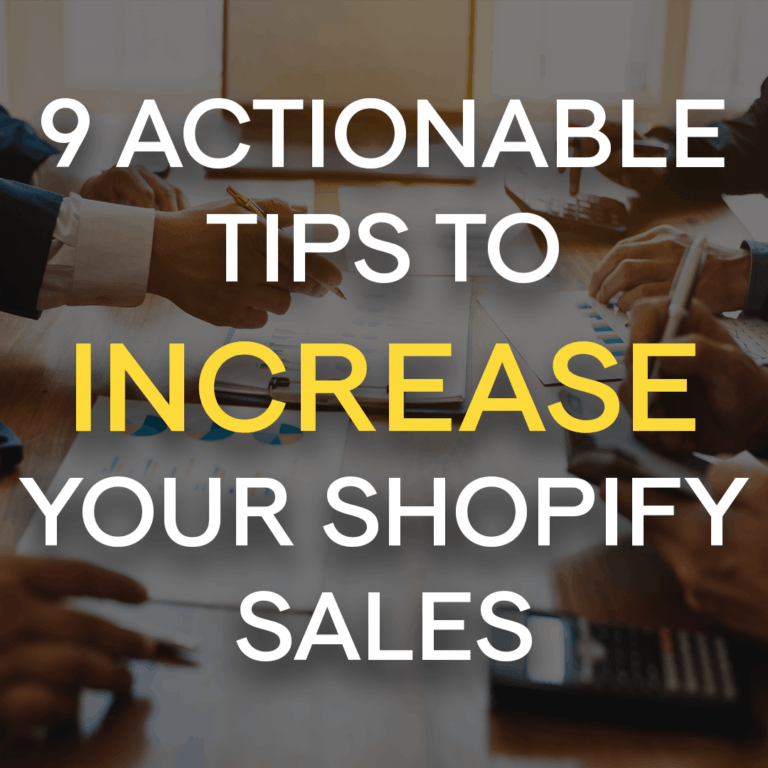Improving online sales is the primary goal of most businesses. In both B2B and B2C, e-commerce has become more important than ever, and one e-commerce platform seems to be leading the way. In recent years, Shopify has seen immense e-commerce growth and its popularity isn’t surprising. The platform is designed to help people build their own, scalable online store with hundreds of built-in features, and tons of apps. It allows businesses to sell products directly on their website, and across multiple marketplaces and social media.
In this blog post, 1WorldSync and Sirv — the leading image hosting, optimizing, and processing platform — have teamed up to provide our best tips and tricks to improve your online sales using the Shopify platform.

Start with Measurable Goals
Before we get started, it’s important to have a plan in place to determine your goals. You can’t manage what you can’t measure, and your goals should be actionable and measurable.
Shopify Analytics works for tracking sales and inventory, but attribution is its weak point. This might not seem like a big deal at first, but when you start running marketing campaigns, your attribution needs to be spot-on. Otherwise, you’ll waste your ad budget. We recommend using an external analytics service, like Google Analytics.
Use this guide on Google Analytics installation, and the official Shopify documentation to set up your analytics.
Tip 1: ABAB – Always Be A/B Testing
After you have your analytics set up, you can track what’s working to increase your Shopify sales.
Here’s the catch: it’s not as easy as it may seem to track the impact of changes you make to your Shopify store on your sales.
Some time frames can be busier than others, and a change you’ve made could coincide with a new marketing campaign, bringing in quality high–converting traffic. On the contrary, one of your products could hit the front page of a Reddit post and lead thousands of visitors to your site who aren’t interested in buying.
In all of these cases, it’s often impossible to determine what caused an increase or decrease in conversions. That’s where A/B testing comes in – it’s a scientific way to test the impact of the changes on your conversion rate.

How does A/B testing work?
A/B testing is an experiment where two variations of your page/s are shown to users at random, then statistical analysis is used to determine which variation performs best for a given conversion goal.
Does Shopify offer native A/B testing?
No, Shopify does not offer built-in tools for A/B testing, so you’ll have to rely on an external tool.
What A/B testing tool to choose for Shopify?
- Google Optimize – An A/B testing platform from Google with great Google Analytics integration and an easy to use interface. To learn how to set it up with Shopify, refer to this guide.
- VWO – Visual Website Optimizer is another easy–to–use tool for running A/B tests on Shopify. Here’s how to integrate VWO with Shopify
For more in-depth A/B testing advice, you can refer to this Shopify blog post here.
Additionally, if you’re looking for A/B testing ideas, Sumo has compiled a helpful list here.
Tip 2: Have a Clear Call–to-Action
What is a Call–to–Action (CTA)?
A CTA is a link or a button that signals the most-desired action to your site visitors. This action will vary from page to page, and different CTAs will serve different functions throughout the customer journey.
Tips for creating CTAs you can’t help but click
Place your main CTA above the fold
‘Above the fold’ is the part of the page that is immediately visible to your users. Here’s a typical fold:
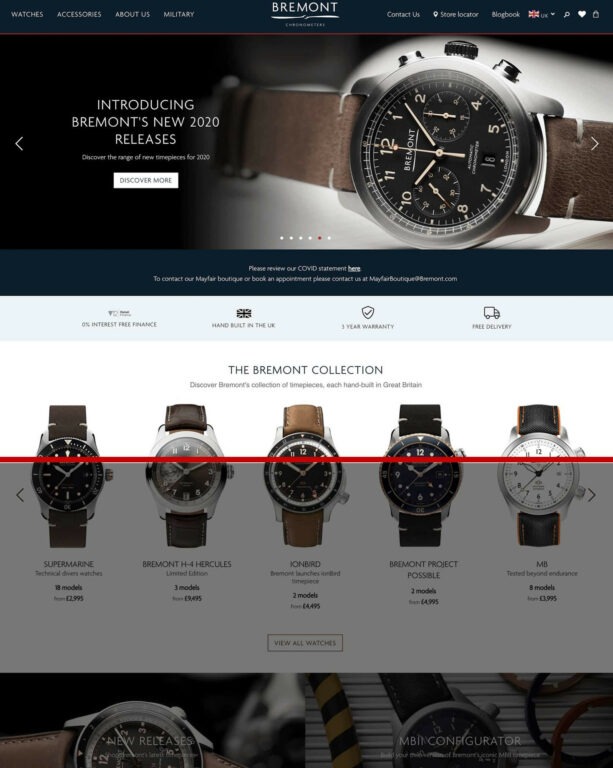
In 2010, users spent about 80% of their time viewing content above the fold. More recent studies show that user behavior has changed and the time they spend viewing content above the fold dropped to 57%. Regardless, placing your CTAs above the fold is still very important.
Create Urgency
Experiment with your call–to–actions by supplementing them with items that add urgency.
- Low stock warnings
- Today only deals
- Current viewers and recent purchases
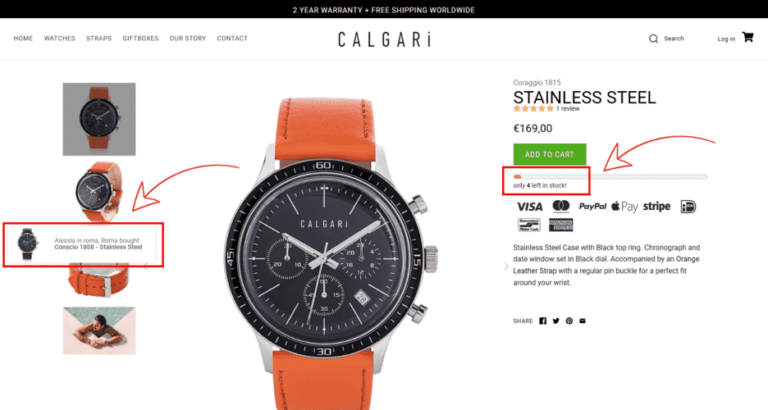
See what Calgari watches did there? You can use an app like Urgency Bear to achieve a similar effect.
Use simple and proven phrases
Try to stick to battle-tested and familiar phrases. Some of the most common e-commerce CTAs include this copy:
- Homepage: Shop now, Shop the collection
- Collection/category page: Buy now, Buy now with 1-Click
- Product page: Add to Cart/Bag, Buy now
- Cart: Checkout
- Checkout: Pay now
Test CTA design and colors
So, you have your important CTAs placed above the fold, the copy is impeccably engaging, but your conversions are still low. What gives? You might want to investigate your CTA design and colors. If your CTA’s color contrast is bad, or if the button itself is too small, people may just miss it, or get distracted by other elements of your page.
When creating CTAs, make sure to:
- Use contrasty colors.
- Use readable fonts.
- Size matters.
It’s especially easy to miss a CTA on a mobile device, so be sure to make your important CTAs big and noticeable.
Place important information near the CTA on product pages
- Price (including any discounts)
- Availability
- Delivery Policy
- Aggregate Reviews
- Color, size, and quantity options
Tip 3: Provide Great Product Detail Page UX
Shopify has well optimized cart and checkout pages, but the product detail page (PDP) design is entirely up to you.
These pages are critical for a successful Shopify store. Getting them right is very important, as they can make or break a sale.
Here are some crucial elements you need on a product detail page:
- Recognizable image(s) is the focal point of all product detail pages. Make sure to include high resolution, zoomable product photos. Having at least one in-scale image can be important for some products.
- Image Zoom. After the global e-commerce shift to mobile, product images must be zoomable. Here’s one of the top-rated Shopify image zoom apps.
- 360-degree spins including image zoom have been effective in increasing conversion rates and decreasing returns. This is even more important now during Covid-19 times. Check out how 360 spins help Shopify store owners. (example)
- A concise Product description to communicate information that provides additional details, augmenting your product images and 360-degree spins. Get straight to the point.
- Price. Be honest.
- Product availability. Users can get frustrated if you don’t communicate clearly the stock status of your products. Out of stock? Allow users to add the item to cart, but clearly communicate that shipping will be delayed. Alternatively, set up restock notifications.
- Add to cart should be clearly visible with visual feedback. Make it obvious that the item has been added to the cart. (example)
- Product options. This is especially important if items can’t be added to cart without a variation being chosen. Make sure to make other important elements related to your variations like pricing and availability clear too.
- Shipping policy. Lack of this information on the product page could be enough for some users to turn to your competitors. Be sure to list your shipping conditions on the product page. If your shipping is complex, consider adding a link to a shipping calculator.
- Product reviews. Reviews should be filterable or sortable by rating, ideally with a rating distribution summary. Apps like Yotpo can help doing this.
- Add a Wishlist. Adidas’ approach does not require you to sign up, but encourages you to do so.
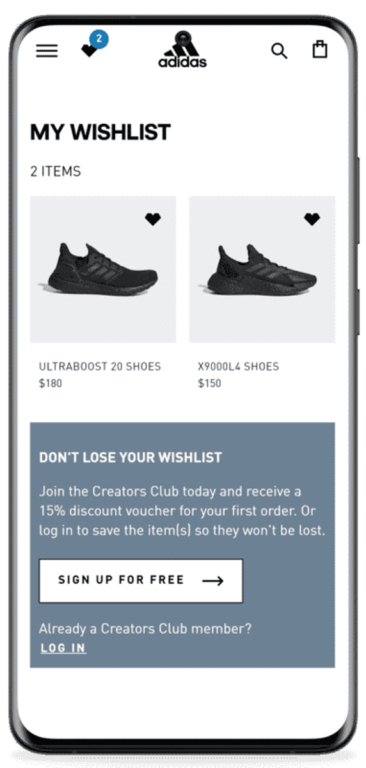
You can replicate this behavior in Shopify with this app.
Tip 4: Go Beyond Regular Product Images with 360-degree Images + Video
The product gallery is the single most important source of information in your Shopify store. A lot of customers will make a buying decision based on product imagery alone.
During the Covid-19 pandemic, many people who didn’t shop online have now started doing so. A common concern among this group (and most online shoppers) is product returns. Simple product images might not be enough today.
360-degree Spin Images
360° Images are interactive experiences which allow buyers to rotate your product around and up and over to mimic what they would do in a store. 360° imagery gives people the opportunity to fully explore a product and reduce or eliminate any doubt they have selected the right item.
Here’s what actual Shopify store owners have to say about 360-degree spins:
Q: Have your sales increased since you added 360-degree spins?
A: We have seen our sales increase as a result. Customers are spending significantly more time on the page & can see the product from all angles. It allows them to access high-ticket products on their computer screen and see all the necessary ins & outs before making a purchase without ever having to come into a brick & mortar store. It’s great!
Q: Have you noticed a decline in order returns (unwanted cancellations)?
A: Yes – absolutely. As customers now know all the intricacies from top to bottom of our mobility scooters & electric wheelchairs. There are no surprises like we had before when customers weren’t able to view the product in 360 degrees. They can do this from the comfort of their home, and it helps our business so much!
Q: Have you noticed any other benefits since adding 360-degree spins of your products?
A: Customers are able to see a more detailed view of each armrest, footrest, how the chair looks, where the battery goes, etc. so when the product arrives at their door, they are already intimately familiar with the different features and functions of their mobility equipment. We value the technology so much!
–Scott Zabriskie, CEO, Scooters ‘N Chairs
“My belief is that the 360-degree spin technology helped us get a partnership with Goldbelly.com and a story in the Washington post. Not only that, it adds to our credibility as a brand instantly. Our sales tripled after implementing the technology although to be fair, we didn’t promote the site much before that. When we were on a call with a buyer from QVC, she commented on how great the images were.”
–Robin Davis, Owner, Big Shake’s Hot Chicken
My belief is that the 360° spin technology helped us get a partnership with Goldbelly.com and a story in the Washington post. Not only that, it adds to our credibility as a brand instantly. Our sales tripled after implementing the technology.
Robin Davis, Owner, Big Shake’s Hot Chicken
Product videos
Videos work great for more complex products that require “how-to” explanations of a function or even installation. The best product videos are branded and tell a story. Videos should put your product in context, showing the product in use or why it’s valuable. A compelling video is a great way to re-iterate your brand values and promises that can be repurposed throughout your marketing channels, but it doesn’t replace imagery.
Tip 5: Personalization in Upsells & Cross–sells
Upselling and cross-selling is both the art and science of introducing customers to better or complementary products based on their current interest.
Well-executed upselling and cross-selling can lead to a boost in revenues by selling more to the same customer. Additionally, your customer benefits by making sure they are choosing the right product and have everything they need to use that product. This is where personalization is important. You want to make sure upsells and cross-sells are customized and relevant to that shopper. Always consider the experience from a customer’s perspective.
For example, you can re-engage customers before or after payment by showing a message which indicates: “people who bought this, also bought this.” There are several apps that help with these product suggestions.
Tip 6: Use Search Engine Optimization
Shopify is SEO friendly out of the box, but it does have some shortcomings.
Avoid duplicate content
Shopify themes often reference the collection URL and not the canonical ‘/products/” URL. This sends mixed signals to Google. So, let’s address the issue; it’s an easy fix in the theme most of the time. Get your developer to do this, and use this Moz guide Link.
Write unique product descriptions
In order to write a great product description that will boost your sales as well as Google rankings, it has to:
- Help the buyer make the purchasing decision
- Answer the questions that product images or 360 spins can’t
- Highlight the benefits (features) of the product thoroughly
- Target the right SEO product keywords
Optimize images for search
Images bring in a lot of quality traffic so it’s imperative to optimize them. Sirv has written a comprehensive guide on image optimization.
Additionally, 1WorldSync adds keyword metadata to your 360-degree spin images, which allows them to be categorized by search engines and reinforces the most important features of your products to improve SEO results.
Add structured data
Structured data is a special type of mark-up, which provides key information about your product.
Google and other search engines integrate structured data into their search results. Implementing structured data can improve the visibility of your Shopify store on the web.
Consider adding these types of structure data to your Shopify store:
1. Review stars
2. Product information in google image search
3. Shipping information
Read this guide for more information.
How to add structured data to Shopify?
This is best done by your developer to add it to your theme, and we wouldn’t recommend relying on apps for this functionality.
“When doing SEO for Shopify, much like with any CMS or website, it is important to align your strategies with the goal that Google has for their users – showing the most relevant and authoritative content within their search results (their product) for the searchers’ query. So when thinking about SEO, remember it’s a business strategy; inclusive of publishing, brand building, marketing, website experience, and technical SEO.”
– Bill Ross, Founder, Linchpin SEO
Tip 7: Focus on Email Marketing
Email marketing is one of the best channels to connect with your customers and generate sales. According to Barillance, average email marketing ROI in e-commerce is 3,800%, or $38 for every $1 invested.

Here are some email campaigns every Shopify store should have:
- Welcome Email. These tend to have the highest open rates and helps to get the customer hooked with a discount.
- Referral email. If you can get your customers to share your store with a friend, give them both a discount.
- Cart abandonment. This email is important to remind customers that they forgot some stuff in their cart. Be creative and try to stand out.
- Order confirmation. In these emails, you should try to upsell or ask for a review.
- Upsell Email. Encourage your customer to buy more. Use their buying history to advertise more products.
- Win-back Email. Customer hasn’t shopped for a while? Send them a reactivation email with an offer or a curated collection of products they might be interested in. Personalization really helps with this.
- Survey. Use Incentives; people don’t like surveys unless you throw in a gift card or a nice discount.
- Thank you. Make this email fun and shareable.
If you’re looking for inspiration, check out some examples of really good emails.
Tip 8: Use Social Proof in User Reviews
Social proof is a psychological phenomenon where people assume the actions of others to reflect correct behavior for a given situation. Humans view behavior as “more correct” if they see others doing it, too.
Here are a few ways you can use social proof in user reviews to improve trust and authenticity in your products:
- Publish user-uploaded product images
- Show the number of products sold
- Display expert reviews for your products’ endorsements
- Mark your best products as “Popular Choice”
- Display contextual details (such as location and age) to allow users to identify with the reviewer
- Add human pictures to your testimonials
Tip 9: Reduce friction at check-out
The last thing you need is someone to abandon their cart because the check-out process was too confusing or tedious. Your goal is to make the check–out process as intuitive and painless as possible. Don’t barricade the check-out with ads, coupons, additional offerings, or other distractions. And for repeat customers, consider express check-out options.
Don’t ask for unnecessary information
No one likes filling out forms. Only request the necessary information from your customers during the check-out process. For example, allow them to pre-fill the billing address from the shipping address. Making the form as simple and quick as possible will lead to fewer cart abandonments.
Shopify allows you to configure some checkout fields:
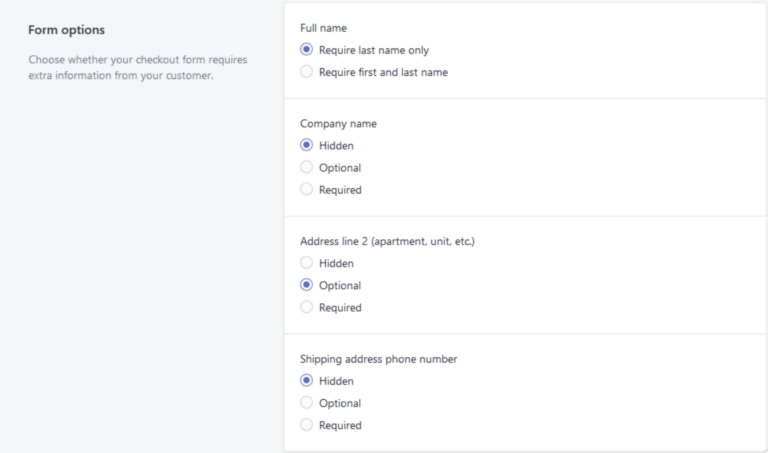
Additionally, you can edit the default copy of the checkout page by customizing your theme.
Keep Your Customers Happy
It’s important to make a long term investment in your customers. Keeping them happy is the ultimate goal, and that can be done by a) having a product that wows them, and b) providing a pleasant and seamless shopping experience. All of the tips above are provided to help you over-deliver on the customer experience, and, in turn, improve your e-commerce sales.
1WorldSync is here to help you along the way. Get in touch with us to learn how to get your product imagery online quickly and enable your website to showcase high-resolution, high-caliber, and interactive spinning imagery.
